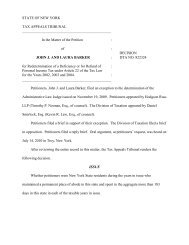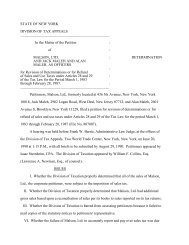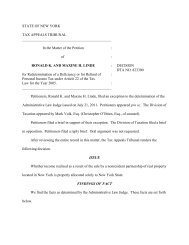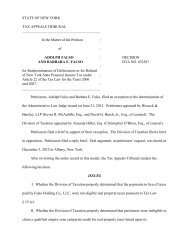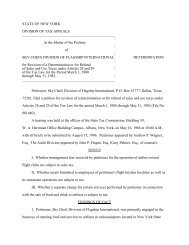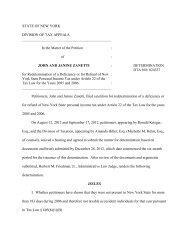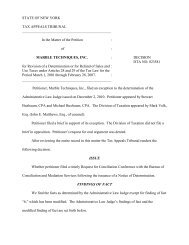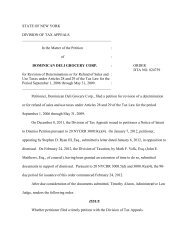STATE OF NEW YORK TAX APPEALS TRIBUNAL In the Matter of ...
STATE OF NEW YORK TAX APPEALS TRIBUNAL In the Matter of ...
STATE OF NEW YORK TAX APPEALS TRIBUNAL In the Matter of ...
Create successful ePaper yourself
Turn your PDF publications into a flip-book with our unique Google optimized e-Paper software.
<strong>STATE</strong> <strong>OF</strong> <strong>NEW</strong> <strong>YORK</strong><br />
<strong>TAX</strong> <strong>APPEALS</strong> <strong>TRIBUNAL</strong><br />
________________________________________________________<br />
<strong>In</strong> <strong>the</strong> <strong>Matter</strong> <strong>of</strong> <strong>the</strong> Petitions :<br />
<strong>of</strong> :<br />
CONSTANCE LaPENNA and FRANK LaPENNA, : DECISION<br />
<strong>OF</strong>FICERS <strong>OF</strong> LaPENNA ELECTRIC CONTRACTORS, INC.<br />
:<br />
for Revision <strong>of</strong> Determinations or for Refunds <strong>of</strong> Sales and Use<br />
Taxes under Articles 28 and 29 <strong>of</strong> <strong>the</strong> Tax Law for <strong>the</strong> Period :<br />
June 1, 1983 through May 31, 1984.<br />
________________________________________________________<br />
The Division <strong>of</strong> Taxation filed an exception to <strong>the</strong> determination <strong>of</strong> <strong>the</strong> Administrative<br />
Law Judge issued on November 30, 1989 with respect to <strong>the</strong> petitions <strong>of</strong> Constance LaPenna and<br />
Frank LaPenna, <strong>of</strong>ficers <strong>of</strong> LaPenna Electric Contractors, <strong>In</strong>c., 18 Sunrise Drive, Middletown,<br />
New York 10940 for revision <strong>of</strong> determinations or for refunds <strong>of</strong> sales and use taxes under<br />
Articles 28 and 29 <strong>of</strong> <strong>the</strong> Tax Law for <strong>the</strong> period June 1, 1983 through May 31, 1984 (File Nos.<br />
802497 and 802498). Petitioner appeared by Bull, Morreale, Judelson & Clancy (John M.<br />
Clancy, Esq., <strong>of</strong> counsel). The Division <strong>of</strong> Taxation appeared by William F. Collins, Esq. (Irwin<br />
A. Levy, Esq., <strong>of</strong> counsel).<br />
1990.<br />
Petitioners and <strong>the</strong> Division both filed briefs. Oral argument was heard on September 26,<br />
After reviewing <strong>the</strong> entire record in this matter, <strong>the</strong> Tax Appeals Tribunal renders <strong>the</strong><br />
following decision.<br />
ISSUE<br />
Whe<strong>the</strong>r petitioners were persons required to collect sales and use taxes on behalf <strong>of</strong><br />
LaPenna Electric Contractors, <strong>In</strong>c. within <strong>the</strong> meaning and intent <strong>of</strong> Tax Law §§ 1131(1) and<br />
1133(a) for <strong>the</strong> period at issue herein.
-2-<br />
FINDINGS <strong>OF</strong> FACT<br />
We find <strong>the</strong> facts as determined by <strong>the</strong> Administrative Law Judge. These facts are set forth<br />
below.<br />
LaPenna Electric Contractors, <strong>In</strong>c. (hereinafter "<strong>the</strong> corporation") operated an electrical<br />
contracting business at 14 Rondack Road, Middletown, New York 10940. The corporation<br />
began business in November 1976 and filed for bankruptcy in 1984.<br />
On June 14 and 17, 1985, <strong>the</strong> Division <strong>of</strong> Taxation issued two notices <strong>of</strong> determination and<br />
demands for payment <strong>of</strong> sales and use taxes due to petitioner Constance LaPenna spanning,<br />
toge<strong>the</strong>r, <strong>the</strong> period June 1, 1983 through May 31, 1984 and assessing a sales tax liability in <strong>the</strong><br />
aggregate amount <strong>of</strong> $7,322.64, plus penalty (Tax Law § 1145[a][1]) and interest. On June 17,<br />
1985, <strong>the</strong> Division <strong>of</strong> Taxation issued two additional notices <strong>of</strong> determination and demands for<br />
payment <strong>of</strong> sales and use taxes due spanning <strong>the</strong> same period and assessing <strong>the</strong> same amounts as<br />
above, against petitioner Frank LaPenna. All notices indicated that <strong>the</strong> amount <strong>of</strong> tax due was<br />
owed by <strong>the</strong> corporation and that <strong>the</strong> petitioners were being assessed as persons required to<br />
collect and remit taxes on behalf <strong>of</strong> <strong>the</strong> corporation because <strong>the</strong>y were <strong>of</strong>ficers <strong>of</strong> such<br />
corporation.<br />
The amount <strong>of</strong> tax due for <strong>the</strong> quarters ended August 31, 1983 and November 30, 1983<br />
was based upon <strong>the</strong> sales tax returns as filed by <strong>the</strong> corporation without full payment <strong>of</strong> <strong>the</strong> tax<br />
reported to be due <strong>the</strong>reon. The amount <strong>of</strong> tax due for <strong>the</strong> quarters ended February 29, 1984 and<br />
May 31, 1984 was based upon <strong>the</strong> average taxable sales as reported on previous returns filed, as<br />
no sales tax returns had been filed for <strong>the</strong>se periods.<br />
Subsequent to <strong>the</strong> issuance <strong>of</strong> <strong>the</strong> notices <strong>of</strong> determination, <strong>the</strong> corporation late filed sales<br />
tax returns for <strong>the</strong> quarters ended February 29, 1984 and May 31, 1984. The tax shown due was<br />
not remitted with <strong>the</strong> sales tax returns. At a Tax Appeals Bureau conference, <strong>the</strong> total tax due<br />
was reduced to reflect <strong>the</strong> amounts shown on <strong>the</strong> filed sales tax returns. The amount now in<br />
issue is as follows:
-3-<br />
Quarter Ended<br />
Tax<br />
August 31, 1983 $ 251.65<br />
November 30, 1983 1,875.79<br />
February 29, 1984 910.06<br />
May 31, 1984 1,585.84<br />
TOTAL $4,623.34<br />
Constance LaPenna was <strong>the</strong> president and a shareholder <strong>of</strong> <strong>the</strong> corporation during <strong>the</strong><br />
period in issue. Her name, title, social security number and address appear on <strong>the</strong> Certificate <strong>of</strong><br />
Sales Tax Registration form filed by <strong>the</strong> corporation with <strong>the</strong> Division <strong>of</strong> Taxation. On<br />
March 15, 1984, Constance LaPenna signed, as president, a New York State Application for<br />
Three-Month Extension for Filing Tax Report, Form CT-5, for <strong>the</strong> corporation for <strong>the</strong> year 1983.<br />
Her husband, Frank LaPenna, was <strong>the</strong> vice-president, secretary and a shareholder <strong>of</strong> <strong>the</strong><br />
corporation during <strong>the</strong> period in issue. His name, title, social security number and address also<br />
appear on <strong>the</strong> Certificate <strong>of</strong> Sales Tax Registration form filed by <strong>the</strong> corporation with <strong>the</strong><br />
Division <strong>of</strong> Taxation. On May 3, 1983, Frank LaPenna signed, as vice-president, <strong>the</strong><br />
corporation's Corporation Franchise Tax Report, Form CT-3, for <strong>the</strong> year 1981.<br />
Mr. and Mrs. LaPenna became involved in <strong>the</strong> corporation at <strong>the</strong> behest <strong>of</strong> <strong>the</strong>ir son, James<br />
LaPenna. As a card carrying member <strong>of</strong> an electrical contractors union, James LaPenna was<br />
precluded from owning or operating an electrical contracting business. He <strong>the</strong>refore requested<br />
that his parents be <strong>the</strong> <strong>of</strong>ficers and shareholders <strong>of</strong> record <strong>of</strong> <strong>the</strong> corporation and that <strong>the</strong>ir home<br />
address be used as <strong>the</strong> address <strong>of</strong> <strong>the</strong> business. Prior to <strong>the</strong> corporation, Mr. and Mrs. LaPenna<br />
never had any involvement with an electrical contracting business. Mrs. LaPenna was a sales<br />
clerk in a department store before her retirement in 1966. Mr. LaPenna was a cook in a training<br />
school for boys before his retirement in 1978.<br />
During <strong>the</strong> years at issue, nei<strong>the</strong>r petitioner had any duties or responsibilities with regard to<br />
<strong>the</strong> operation <strong>of</strong> <strong>the</strong> corporation. They had no authority to hire or fire employees or to negotiate<br />
contracts. They signed tax returns only at <strong>the</strong> request <strong>of</strong> <strong>the</strong>ir son, but did not participate in <strong>the</strong>ir
-4-<br />
preparation. They never signed checks or o<strong>the</strong>r corporate documents. Mr. and Mrs. LaPenna<br />
were unaware <strong>of</strong> <strong>the</strong> income, payroll, books and records and bank statements <strong>of</strong> <strong>the</strong> corporation.<br />
They never participated in discussions or meetings concerning <strong>the</strong> operation <strong>of</strong> <strong>the</strong> business or<br />
which creditors to pay. Mr. and Mrs. LaPenna did not receive any earnings or dividends from <strong>the</strong><br />
corporation during its existence. The visits made by petitioners to <strong>the</strong> business premises, located<br />
in <strong>the</strong> dining room <strong>of</strong> <strong>the</strong> home <strong>of</strong> James LaPenna and his wife Mary Jo LaPenna, were for<br />
personal, not business, reasons.<br />
During <strong>the</strong> period in issue, James LaPenna operated <strong>the</strong> business. <strong>In</strong> addition, he drafted<br />
checks, negotiated and executed contracts and decided which creditors were to be paid. Along<br />
with his wife, Mary Jo LaPenna, he signed <strong>the</strong> sales tax returns filed for <strong>the</strong> period in issue. The<br />
corporation had one <strong>of</strong>fice employee, a secretary/bookkeeper, who answered <strong>the</strong> telephone,<br />
ordered supplies, handled <strong>the</strong> payroll and made entries into <strong>the</strong> monthly ledger. The<br />
secretary/bookkeeper was hired by and reported to James LaPenna.<br />
OPINION<br />
<strong>In</strong> his determination below, <strong>the</strong> Administrative Law Judge concluded that petitioners were<br />
not persons required to collect tax on behalf <strong>of</strong> <strong>the</strong> corporation. The Administrative Law Judge<br />
reasoned that although petitioners apparently had <strong>the</strong> authority to sign tax returns, <strong>the</strong>y did so<br />
only at <strong>the</strong> direction and request <strong>of</strong> <strong>the</strong>ir son. Fur<strong>the</strong>rmore, <strong>the</strong> Administrative Law Judge found<br />
that petitioners were not responsible for maintaining <strong>the</strong> corporate books or for <strong>the</strong> management<br />
<strong>of</strong> <strong>the</strong> corporation, did not have <strong>the</strong> authority to hire or fire employees, did not have any<br />
responsibility or involvement with <strong>the</strong> financial affairs <strong>of</strong> <strong>the</strong> corporation, nor did <strong>the</strong>y receive<br />
any benefits from <strong>the</strong> corporation's pr<strong>of</strong>its throughout its existence. Lastly, <strong>the</strong> Administrative<br />
Law Judge found it significant that petitioners were not engaged in <strong>the</strong> preparation and filing <strong>of</strong><br />
<strong>the</strong> corporation's sales and use tax returns and did not draft checks on behalf <strong>of</strong> <strong>the</strong> corporation.<br />
<strong>In</strong> its exception, <strong>the</strong> Division argues that petitioners are responsible persons for <strong>the</strong><br />
collection <strong>of</strong> sales tax. The Division asserts that <strong>Matter</strong> <strong>of</strong> Blodnick v. New York State Tax
-5-<br />
Commn. (124 AD2d 437, 507 NYS2d 536) is controlling in this case. The Division contends<br />
that "if <strong>the</strong> assessing party is given information such as corporate position, stock ownerships,<br />
signing <strong>of</strong> returns, <strong>the</strong>n <strong>the</strong> assessing party is not improperly assessing Petitioners" (Division's<br />
exception).<br />
The Division states that since petitioner Constance LaPenna was president <strong>of</strong> <strong>the</strong><br />
corporation and owned 100% <strong>of</strong> <strong>the</strong> stock, 1 had signed form CT-5 as an <strong>of</strong>ficer <strong>of</strong> <strong>the</strong> corporation<br />
for <strong>the</strong> year 1983 and petitioner Frank LaPenna was vice-president <strong>of</strong> <strong>the</strong> corporation and had<br />
signed form CT-3 as an <strong>of</strong>ficer <strong>of</strong> <strong>the</strong> corporation for <strong>the</strong> year 1981, <strong>the</strong> Division was correct in<br />
assessing petitioners.<br />
<strong>In</strong> response, petitioners seek to distinguish <strong>Matter</strong> <strong>of</strong> Blodnick v. New York State Tax<br />
Commn. (supra) from <strong>the</strong> instant case. Petitioners submit that <strong>the</strong>re are significant factual<br />
differences between Blodnick which clearly support <strong>the</strong> determination <strong>of</strong> <strong>the</strong> Administrative Law<br />
Judge. Petitioners argue that in Blodnick <strong>the</strong> petitioners <strong>the</strong>rein failed to disclose <strong>the</strong> parties who<br />
were responsible for collecting <strong>the</strong> taxes at issue. <strong>In</strong> <strong>the</strong> instant case, petitioners pointed to <strong>the</strong><br />
fact that James and Mary Jo LaPenna operated and managed <strong>the</strong> corporation. Moreover, James<br />
and Mary Jo LaPenna signed and filed <strong>the</strong> sales and use tax returns for <strong>the</strong> periods at issue, not<br />
petitioners.<br />
We reverse <strong>the</strong> determination <strong>of</strong> <strong>the</strong> Administrative Law Judge.<br />
Section 1133(a) <strong>of</strong> <strong>the</strong> Tax Law imposes upon any person required to collect tax imposed<br />
by Article 28, personal liability for <strong>the</strong> tax imposed, collected or required to be collected.<br />
Section 1131(1) <strong>of</strong> <strong>the</strong> Tax Law defines persons required to collect tax to include, among o<strong>the</strong>rs,<br />
corporate <strong>of</strong>ficers and employees who are under a duty to act for such corporation in complying<br />
with <strong>the</strong> requirements <strong>of</strong> Article 28.<br />
1<br />
Although <strong>the</strong> Division states in its exception that Constance LaPenna owned 100% <strong>of</strong> <strong>the</strong> stock <strong>of</strong> <strong>the</strong><br />
corporation, <strong>the</strong> record indicates that both Frank and Constance LaPenna were shareholders <strong>of</strong> <strong>the</strong> corporation.
-6-<br />
We agree with <strong>the</strong> Administrative Law Judge that <strong>Matter</strong> <strong>of</strong> Autex Corp. (Tax Appeals<br />
Tribunal, November 23, 1988) <strong>of</strong>fers a useful summary <strong>of</strong> <strong>the</strong> factors which are considered in<br />
determining whe<strong>the</strong>r an individual is responsible for <strong>the</strong> sales and use taxes due from a<br />
corporation. Such factors include:<br />
"[T]he authorization to hire or fire employees, <strong>the</strong> derivation <strong>of</strong><br />
substantial income from <strong>the</strong> corporation or stock ownership<br />
(<strong>Matter</strong> <strong>of</strong> Blodnick v. State Tax Commn., 124 AD2d 437, 507<br />
NYS2d 536); <strong>the</strong> individual's possible shared status as an <strong>of</strong>ficer,<br />
director or stockholder (<strong>Matter</strong> <strong>of</strong> Cohen v. State Tax Commn.,<br />
128 AD2d 1022, 513 NYS2d 564, 565); <strong>the</strong> individual's day-to-day<br />
responsibilities, involvement with, knowledge <strong>of</strong> and control over<br />
<strong>the</strong> financial affairs and management <strong>of</strong> <strong>the</strong> corporation, <strong>the</strong> duties<br />
and functions as outlined in <strong>the</strong> certificate <strong>of</strong> incorporation and <strong>the</strong><br />
bylaws, <strong>the</strong> preparation and filing <strong>of</strong> sales tax forms and returns<br />
(Vogel v. New York State Dept. <strong>of</strong> Taxation & Fin., 98 Misc 2d<br />
222, 413 NYS2d 862, 865); and <strong>the</strong> payment, including <strong>the</strong><br />
authorization to write checks on behalf <strong>of</strong> <strong>the</strong> corporation, <strong>of</strong> o<strong>the</strong>r<br />
creditors o<strong>the</strong>r than <strong>the</strong> State <strong>of</strong> New York and <strong>the</strong> United States<br />
(Chevlowe v. Koerner, 95 Misc 2d 388, 407 NYS2d 427, 429).<br />
Within closely held corporations, 'an <strong>of</strong>ficer's knowledge <strong>of</strong> <strong>the</strong><br />
corporate affairs and his benefits received from corporate pr<strong>of</strong>its<br />
[are] extremely important considerations' (Vogel v. New York<br />
State Dept. <strong>of</strong> Taxation & Fin., supra, 413 NYS2d 862, 865)"<br />
(<strong>Matter</strong> <strong>of</strong> Autex Corp., supra).<br />
Since both sides rely on <strong>Matter</strong> <strong>of</strong> Blodnick v. New York State Tax Commn. (supra) in<br />
arguing <strong>the</strong>ir positions, we begin our analysis with a brief overview <strong>of</strong> Blodnick. <strong>In</strong> Blodnick,<br />
<strong>the</strong>re were two petitioners, Janice Blodnick and Myrna Kanter, who were found to be liable<br />
under sections 1131(1) and 1133(a) <strong>of</strong> <strong>the</strong> Tax Law as responsible <strong>of</strong>ficers. The two petitioners<br />
were <strong>the</strong> only <strong>of</strong>ficers and shareholders <strong>of</strong> <strong>the</strong> corporation. However, <strong>the</strong> petitioners' husbands,<br />
in fact, were in charge <strong>of</strong> <strong>the</strong> corporation and its affairs. Upon <strong>the</strong>ir husbands' requests, <strong>the</strong><br />
petitioners signed <strong>the</strong> sale agreement and <strong>the</strong> o<strong>the</strong>r corporate documents whereby <strong>the</strong>y became<br />
shareholders and <strong>of</strong>ficers. Their husbands hired two managers who were responsible for <strong>the</strong> dayto-day<br />
operations <strong>of</strong> <strong>the</strong> corporation which also included supervising <strong>the</strong> employees <strong>of</strong> <strong>the</strong><br />
corporation. The husbands <strong>of</strong> <strong>the</strong> petitioners also hired a bookkeeper who was in charge <strong>of</strong> all
-7-<br />
<strong>the</strong> financial affairs <strong>of</strong> <strong>the</strong> corporation (<strong>Matter</strong> <strong>of</strong> Blodnick, State Tax Commn., May 21, 1985,<br />
confirmed 124 AD2d 437, 507 NYS2d 536).<br />
The facts in Blodnick are very similar to <strong>the</strong> facts in <strong>the</strong> present case involving petitioners<br />
Frank and Constance LaPenna. Petitioners clearly were <strong>the</strong> only <strong>of</strong>ficers and shareholders <strong>of</strong> <strong>the</strong><br />
corporation. Petitioners' son, James LaPenna, hired <strong>the</strong> one employee <strong>of</strong> <strong>the</strong> corporation, <strong>the</strong><br />
secretary/bookkeeper. James LaPenna was in charge <strong>of</strong> <strong>the</strong> day-to-day operations <strong>of</strong> <strong>the</strong><br />
corporation. Fur<strong>the</strong>rmore, petitioners both were listed as responsible <strong>of</strong>ficers on <strong>the</strong> Certificate<br />
<strong>of</strong> Sales Tax Registration forms on file with <strong>the</strong> Department.<br />
Petitioners continually assert that <strong>the</strong>y were not in charge <strong>of</strong> <strong>the</strong> corporation and never<br />
performed any duties, outside <strong>of</strong> signing tax returns, with respect to <strong>the</strong> corporation. However,<br />
as stated in Blodnick, "<strong>the</strong> fact that petitioners did not in fact exercise <strong>the</strong>ir responsibilities is<br />
irrelevant" (<strong>Matter</strong> <strong>of</strong> Blodnick v. New York State Tax Commn., supra, 507 NYS2d 536, 538).<br />
We conclude that petitioners are responsible persons within <strong>the</strong> meaning and intent <strong>of</strong> section<br />
1131(1) <strong>of</strong> <strong>the</strong> Tax Law because as <strong>the</strong> only shareholders and <strong>of</strong>ficers <strong>of</strong> <strong>the</strong> corporation <strong>the</strong>y<br />
clearly had actual authority over <strong>the</strong> corporation. The fact that petitioners failed to exercise such<br />
authority is, in our view, irrelevant to <strong>the</strong> question <strong>of</strong> <strong>the</strong>ir liability.<br />
Petitioners assert that a major distinction can be made between <strong>the</strong> present case and<br />
Blodnick based on <strong>the</strong> fact that in Blodnick <strong>the</strong> court stated that:<br />
"Given petitioners' positions as <strong>the</strong> sole <strong>of</strong>ficers and shareholders<br />
<strong>of</strong> <strong>the</strong> corporation, toge<strong>the</strong>r with <strong>the</strong> fact that <strong>the</strong>y were unable to<br />
relate who, if not <strong>the</strong>y, was responsible for collection <strong>of</strong> taxes, [<strong>the</strong><br />
State Tax Commission's] finding that petitioners were <strong>the</strong> correct<br />
parties for assessment <strong>of</strong> taxes was nei<strong>the</strong>r arbitrary nor capricious"<br />
(<strong>Matter</strong> <strong>of</strong> Blodnick v. New York State Tax Commn., supra, 507<br />
NYS2d 536, 538 [emphasis added]).<br />
Unlike <strong>the</strong> petitioners in Blodnick who failed to testify that it was <strong>the</strong>ir respective husbands who<br />
were responsible for payment <strong>of</strong> <strong>the</strong> taxes, petitioners argue that <strong>the</strong>y have contended all along<br />
that <strong>the</strong>ir son, James LaPenna, was <strong>the</strong> one who was responsible. Moreover, petitioners go so far<br />
as to argue that <strong>the</strong> Third Department in Blodnick applied a two prong test to determine <strong>of</strong>ficer
-8-<br />
liability. The first prong is whe<strong>the</strong>r a person is an <strong>of</strong>ficer and shareholder <strong>of</strong> <strong>the</strong> corporation,<br />
while <strong>the</strong> second prong is <strong>the</strong> inability or <strong>the</strong> unwillingness to identify who, if not <strong>the</strong>y, was<br />
responsible for <strong>the</strong> collection <strong>of</strong> <strong>the</strong> tax (Oral Arg. Tr., p. 24). We do not interpret <strong>the</strong> court's<br />
comments as an endorsement <strong>of</strong> a two prong test that must be met in order to impose liability<br />
under section 1133(a) <strong>of</strong> <strong>the</strong> Tax Law.<br />
Petitioners are clearly trying to establish that it is <strong>the</strong>ir son who is <strong>the</strong> responsible <strong>of</strong>ficer in<br />
this case. However, it is important to note that more than one person can be held liable as a<br />
responsible <strong>of</strong>ficer (see, <strong>Matter</strong> <strong>of</strong> Blodnick v. New York State Tax Commn., supra, 507 NYS2d<br />
536 [where both <strong>the</strong> petitioners were held liable]). Therefore, merely pointing to one individual<br />
and alleging such individual is a responsible <strong>of</strong>ficer does not necessarily establish that <strong>the</strong> o<strong>the</strong>r<br />
individuals are not responsible <strong>of</strong>ficers as well.<br />
Fur<strong>the</strong>r, petitioners have not demonstrated that <strong>the</strong>y were precluded from exercising <strong>the</strong>ir<br />
authority by <strong>the</strong> acts <strong>of</strong> <strong>the</strong>ir son, James LaPenna (cf., <strong>Matter</strong> <strong>of</strong> Constantino, Tax Appeals<br />
Tribunal, September 27, 1990 [where we concluded that a minority shareholder did not simply<br />
fail to act, but was prevented from acting by <strong>the</strong> power <strong>of</strong> ano<strong>the</strong>r in <strong>the</strong> corporation]). <strong>In</strong>stead,<br />
petitioners have established only that <strong>the</strong>y declined to exercise any responsibility over <strong>the</strong><br />
corporation.<br />
Petitioners assert that it is significant that nei<strong>the</strong>r Constance LaPenna nor Frank LaPenna<br />
signed <strong>the</strong> sales tax returns during <strong>the</strong> period in question. Fur<strong>the</strong>rmore, petitioners argue that<br />
since James and Mary Jo LaPenna signed all <strong>the</strong> returns for <strong>the</strong> period in question, <strong>the</strong> Division<br />
was put on notice that it was James and Mary Jo LaPenna who were responsible <strong>of</strong>ficers, and not<br />
petitioners (Oral Arg. Tr., pp. 15-17). We disagree.<br />
Whe<strong>the</strong>r or not <strong>the</strong> Division was put on notice as to whom was responsible for signing <strong>the</strong><br />
sales tax returns for <strong>the</strong> period in question is irrelevant in determining whe<strong>the</strong>r petitioners were<br />
responsible <strong>of</strong>ficers within <strong>the</strong> meaning and intent <strong>of</strong> <strong>the</strong> Tax Law. The fact that petitioners did
-9-<br />
not sign <strong>the</strong> returns is insufficient to establish that <strong>the</strong>y were not responsible <strong>of</strong>ficers, given <strong>the</strong>ir<br />
status as <strong>the</strong> only shareholders and <strong>of</strong>ficers <strong>of</strong> <strong>the</strong> corporation.<br />
Accordingly, it is ORDERED, ADJUDGED and DECREED that:<br />
1. The exception <strong>of</strong> <strong>the</strong> Division <strong>of</strong> Taxation is granted;<br />
2. The determination <strong>of</strong> <strong>the</strong> Administrative Law Judge is reversed;<br />
3. The petitions <strong>of</strong> Constance LaPenna and Frank LaPenna, as <strong>of</strong>ficers <strong>of</strong> LaPenna Electric<br />
Contractors, <strong>In</strong>c., are dismissed; and<br />
4. The Notices <strong>of</strong> Determination and Demands for Payment <strong>of</strong> Sales and Use Taxes Due,<br />
dated June 14 and 17, 1985, are sustained.<br />
DATED: Troy, New York<br />
March 14, 1991<br />
/s/John P. Dugan<br />
John P. Dugan<br />
President<br />
/s/Francis R. Koenig<br />
Francis R. Koenig<br />
Commissioner<br />
/s/Maria T. Jones<br />
Maria T. Jones<br />
Commissioner




